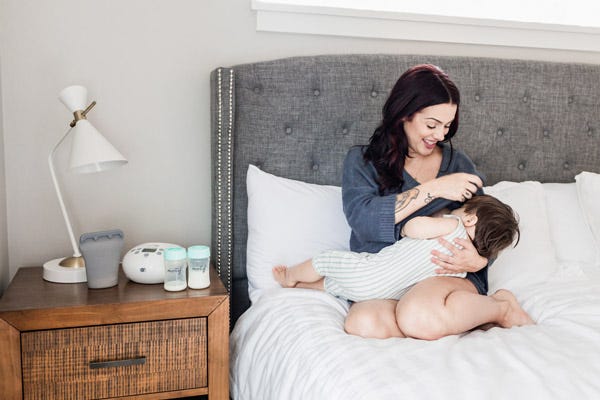Approximately 1 in 3 babies in the United States are born by cesarean section. Some parents plan to have a c-section and some are planning a vaginal delivery and have a cesarean for medical reasons that come up during the birth. Whether you’re planning on having a c-section or not, it’s good for every expecting parent to be familiar with what to expect and how to heal after a cesarean delivery.
#1: Rest Whenever Possible
No matter how you deliver your baby, the most important tip to give any postpartum mom is to REST. Being pregnant is hard work and giving birth is more hard work. Your body needs time to rest and recover from everything it has accomplished over the last 9 months. When your baby is born by cesarean section, its even more essential for you to rest—this was a major surgery and it needs to be treated in the same manner of how you recover from other major surgery.
In order for you to rest comfortably after your c-section, you may need to take pain medication. It’s ok to use it for a little while so that your body can fully relax. Sleep is a critical component to healing, so take pain relievers, either the prescription from your doctor or over-the-counter pain medications like acetaminophen or ibuprofen are fine, if you need them. The pain relief medications may help you sleep more or deeper and that rest will shorten your recovery time. Most people find it easy to rest while they are in the hospital, but it’s important for you to keep resting for at least the first 2 weeks after you get home. This is not the time to push yourself.
Your body has worked hard over the last 9 months of pregnancy and now you’re recovering from major abdominal surgery. You need to take time to rest! This is the perfect time to take advantage of all of the offers of help from family members and friends. Let them be the ones to do your laundry, wash your dishes and vacuum your floors. Although it’s not always the most comfortable thing for many people, this is the time to accept everyone’s offer to help. And maybe you’ll be able to repay the favor to someone in the future!


You should not be picking up anything that is heavier than your baby for the first 2 to 4 weeks and you need to avoid pushing/pulling motions, like those used to rotate laundry or sweep. While you may not always be able to sleep when the baby is sleeping, make every effort to rest every chance you get.
#2: Move to Improve Blood Flow
It may seem contradictory to what I just said about rest, but movement is the second best thing you can do to help your body heal after you have a cesarean. Once your epidural wears off and you’re able to feel your lower extremities, it’s important to move your toes, ankles, and legs. As you are able, start doing leg slides on your bed, and once you are given the ok by your healthcare provider, get up and walk around every couple of hours. Start with small walks around the room, across the house, and slowly work your way up to walking down your driveway.
Movement is important for blood flow and to prevent blood clots after surgery. Slow, gentle movements will also help your body recover. When you need to get out of bed or sit up, roll to the side and use your arms to push yourself upright.
Don’t try to use your abdominal muscles or your back! Once you get home, make sure you keep walking around your house frequently. If you feel abdominal pain or discomfort when you are moving around, try wearing a postpartum compression garment to support your core, incision site, and pelvic floor while you’re moving. As you continue to heal and become more active, you may also benefit from using Motif Medical’s C-Section Dressing System. These breathable bandages are designed to conform to your body and provide stabilization and gentle compression to your incision site as you heal and move around.
One thing you’ll want to avoid as you move around in the first several weeks is stairs. If you do need to go up and down stairs, make sure to go slowly and use the railing for support.
Movement will get easier as time goes on, but don’t be surprised if you feel stiff and sore the first few days. The aches and soreness should get better over time, but make sure to call your Ob-Gyn if you suddenly feel worse or if your incision pain isn’t improving with time.
#3: Drink Lots of Water
The very last thing anyone wants to be after they’ve given birth is constipated. The medications you were given during surgery can slow down your digestion and make you prone to constipation, so make sure you stay hydrated both before and after delivery. Aim for at least 3 quarts of water a day, eat lots of fiber rich foods and consider having a stool softener or fiber supplement on hand, in case you need additional help to get things moving.
Aim for at least 3 quarts of water a day, eat lots of fiber rich foods and consider having a stool softener or fiber supplement on hand. Drinking lots of water helps build your breast milk supply too, so it’s doubly important when you’re breastfeeding.
Drinking lots of water is good for breastmilk supply, too, so it’s doubly important if you’re breastfeeding. Once your urinary catheter has been removed, drinking plenty of water will also make you need to go to the bathroom frequently. And there’s nothing like a full bladder to encourage you to get up and move around! Earlier I talked about movement in relation to good blood flow, but it helps prevent constipation, as well! Don’t push yourself too much too soon, but those short walks around your room will help keep everything moving.
#4: Breathing Exercises
Immediately after surgery, take the time to reconnect with your breath. Your abdomen has had a whole lot of change happen in a very short amount of time. Reconnect your mind with your diaphragm and your rib cage. Feel your lungs fill up and your ribs expand to the front and the back and feel your diaphragm pull down into your abdomen. Practice deep breathing techniques several times a day, as it is great for helping restore good breathing habits, heal your core, and calm your mind.
#5: Wear a Postpartum Recovery Garment
Speaking of your core…your back, pelvic floor, and abdomen can benefit from a little help in the postpartum, so a postpartum support garment or support belt is a wonderful tool to aid in your recovery. Coughing, sneezing, or laughing can be painful at your c-section incision, so if you don’t have a recovery garment, put a pillow over your abdomen and give some counter-pressure before doing those things. As you start being more active and returning to your everyday activities, wear your postpartum recovery garment to help you maintain good posture and establish good movement habits while your muscles are still healing.
#6: Proper Breastfeeding Positions
If you are breastfeeding your baby, it can be difficult to find a way to hold your baby that doesn’t hurt your incision. But there are many good C-section friendly breastfeeding positions that are more forgiving in the healing process. That’s why the football hold is a favorite after a cesarean birth. It allows you to see your baby’s mouth and lips for latching purposes, but isn’t putting any pressure on the incision site.


Side-lying is another great option, but many new moms find this position a little more challenging in the first few days. It gets easier as time goes on, so if it doesn’t work for you at first, try it again in a week or two. The beginning of every breastfeeding relationship is a bit of trial and error as your new baby is figuring out the best way to latch on and hold the nipple in their mouth while feeding, so give yourself and your baby lots of patience and grace. Meeting with a lactation consultant can be an enormous aid in problem solving any obstacles you might face and help you feel more confident in breastfeeding.
Make sure you get in touch with your provider if you start having any signs of infection, if your lochia (vaginal bleeding) increases, or if you are experiencing symptoms of postpartum depression. Even if you’re feeling good, make sure you follow up with your doctor at six weeks to ensure healthy postpartum recovery.







